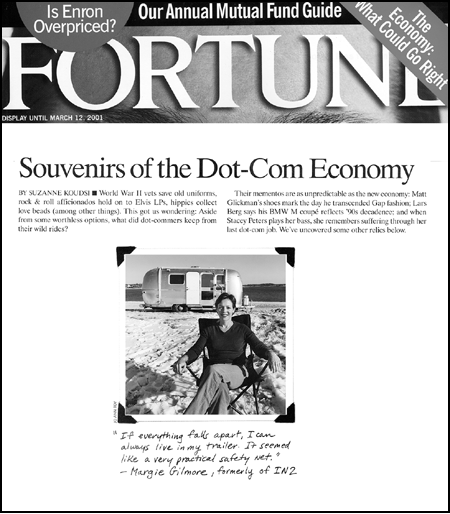Prologue 1
- Why We Did It -
Heather

It was nearly 90 degrees when we sat down for the Cal Arts commencement ceremony. I was wearing black leather and trying to cool off by I drinking from a communal bottle of warm tequila. For two years, I had exhaustively documented my relationship with my mother. In the end, it got me an MFA and $20,000 in bills that I was eventually going to ask her to pay. Discomfort, intoxication, and awkward family politics couldn’t damper the moment. I was excited and believed that after all my intense work great things were happening. I was going to follow along the path forged by Tina Barney, Larry Sultan, and Sally Mann.
I wish my conviction lasted as long as the heat rash did.
Two years later, I had a storage closet filled with dusty camera equipment, a stack of unpaid bills and the epiphany that a degree in conceptual photography wasn’t exactly a hot ticket. The only people impressed with my diploma were the collectors at Sally Mae and the first year students in the photo department. After a series of shows that went nowhere, I lost my swagger and passion. Thankfully, I had Lisa, my girlfriend of two years, to love and support me through the hard times. She never mentioned the sureness I had once felt, came from the isolated utopia of a school environment filled with mentors and collaborators. Lisa never pointed out that without a burning passion or the ability to afford a room of my own, I had a tough road ahead of me. Instead, on my darkest night, when I woke her to explain, “I am not always going to be like this, ” she covered me with her arms and whispered in my ear the words every struggling photographer longed to hear, “I love you. Let’s sell your camera on Ebay.”
I had to say, I was tempted, at least to try and sell my large format studio camera. It was an expensive and precious camera my mother gave me when I went back to school. Even in the best of times, I rarely used it. I preferred the 35mm snapshot aesthetic, favored by a handful of fine-art photographers and children playing with their first disposable. My huffing and cursing as I buckled under the weight of a thirty-pound camera agitated my subjects. Friends and relatives in various stages of mouthing “are you alright?” were not the spontaneous moments I hoped to capture. But, when it came down to it, I wasn’t ready to sell anything. I needed to know, that when the time came, I had the equipment to impersonate a professional. It seemed that for once I made the right decision.
A month later, I heard about an opening for an in-house photographer at an art gallery. The job requirements were possession of a large format camera, close proximity to the Miracle Mile, and a MFA (preferred). It didn’t strike me as odd that the prerequisites were intentionally vague. I didn’t flinch when I saw there was a job posting for seemingly every position in the gallery. I was so excited about the prospect of earning money and being around art, that I didn’t even bother questioning any of the details. In hindsight, I should have done a little research.
Mr. Easter was an art dealer with galleries in Los Angeles, New York and Mexico City. He was known for his spacious exhibit space and constricted ethics. When I met him, his two pet projects were negotiating multiple sales of Smithson’s public environmental installation “Spiral Jetty” and designing a grid of video cameras to spy on his staff. Talent and experience were never brought up in the interview. I was hired because, in addition to having my own equipment, I could pepper a conversation with “panopticon” and “voyeurism,” and was bred from Anglo stock.
I spent my mornings researching a surveillance system so complex it required small trained animals to pull wiring through tiny ducts in the ceiling. My afternoons were dedicated to lumbering heavy camera equipment through 30,000 sq. ft. of gallery space. It was noted I was a very slow walker and given a child’s foot scooter to help me navigate the expanse in a timely matter. When it became clear that a set of wheels weren’t going to change the way I moved, Easter called me into his office and demanded I replace my sloth-like pace with something more of a power strut. He had berated me for placing a stamp on an envelope that was not equidistant from the top and right edges, screamed at me for talking to the artists and shrieked when I used too much film. When he told me to move faster, there was something milder in his tone that made it seem like he was offering a helpful piece of advice I could take or not. I had no idea lacking a crisp professional walk would be the official basis for my termination.
News spread that I had expensive camera equipment. A friend called needing shots of James Taylor for a series of stage projections for his next tour. She assured me it would be a straightforward, easy shoot. So simple, in fact, even someone with an MFA could handle it.
James Taylor greeted us at the door of his home in the Berkshires, introduced us to his wife and offered us coffee. We chatted amicably while I set up the equipment in his living room. Evidently, we all had overestimated my ability to behave like a sensible professional.
Ideally, a studio photographer should assume the role of director, confidant, and fluffer. I took a stalkarazzi approach that better suited my combination of nerves and introversion. I hid behind light stands and tripods in an effort to make myself inconspicuous. Every time the shutter clicked, James Taylor flinched and scanned the room like he was receiving a low voltage electric shock from an invisible source. The shoot was not going well. In a desperate attempt to save the day from pure disaster, his wife suggested he take off his shirt – because, bare skin always puts people at ease.
After a brief moment of hesitation, he slowly pulled off his shirt, neatly folded it on the coffee table and took his seat back in front of the lights. If I had found myself topless in a room with a creeper taking pictures I would’ve left immediately. Evidently, James Taylor is a braver person than I am and, unfortunately much hairier. When his publicist received a stack of film filled with his naked body desperately clutching his guitar, they decided to go in a “different direction.” What I had hoped would be a stepping-stone to other and more lucrative jobs, turned into the “scared and angered American Icon” section of my resume.
Margie
 Five years ago, Margie was part of an Internet company that went public. In the abstract accounting of stock options, her pseudo-worth skyrocketed to over two million dollars. Against the recommendations of friends, family, and financial consultants, she cashed in a fraction of her options and left New York City. She bought a large farmhouse and moved to the country to pursue music appreciation in the form of an extensive karaoke collection and self-taught drum lessons. Very few life choices were less productive than my own, but if any came close, it had to be trying to subsist off stock options from an Internet company.
Five years ago, Margie was part of an Internet company that went public. In the abstract accounting of stock options, her pseudo-worth skyrocketed to over two million dollars. Against the recommendations of friends, family, and financial consultants, she cashed in a fraction of her options and left New York City. She bought a large farmhouse and moved to the country to pursue music appreciation in the form of an extensive karaoke collection and self-taught drum lessons. Very few life choices were less productive than my own, but if any came close, it had to be trying to subsist off stock options from an Internet company.
When the Internet-bubble burst, Margie had two thousands songs her friends, family, and financial consultants could sing along to, a cymbal beat that did not match her bass, and a share in a company that (although it had survived) lost ninety-eight percent of its value. Aside from the largest private karaoke library north of the Mason-Dixon, the only valuable possession she had was her land and farmhouse. She was forced out of retirement at the age of thirty-four.
Margie moved to Los Angeles to start a job working on a new daytime talk show. After spending six months listening to the host attempt to cure problems ranging from bulimia, to infidelity, to chronic anger with a patented, “How’s that working for ya?” Margie realized it wasn’t, and quit. She left her 8 to 7 job to spend her days sitting on a bench at the “The Grove,” a shopping mall modeled after the long gone idyllic small town charm immortalized by Norman Rockwell and perpetuated by Disney. No one had the heart to break it to Margie, a transplanted New Yorker looking for a sense of community, that, “The Grove” was not really a neighborhood, but rather a marketing strategy. But something about the faux charm appealed to her and she spent every day there, flashing her Valued Customer Card like a well-earned key to the city.
The day The Grove introduced imitation snow into their imitation neighborhood repertoire; Margie nestled down with a hot dog and lemonade at her “office-bench” and she spent the day watching “fresh snow” glisten off the buildings of “Main Street.” As the identical synthetic snowflakes landed on the identical synthetic noses of the crowd, something snapped inside Margie – she reached her limit for faux… stock options, self-help gurus, snow, and villages. She craved the real thing and was no longer able to find solace in Small Town, USA, Ltd.
